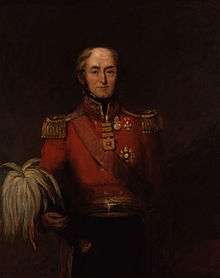Edward Barnes (British Army officer)
| Lieutenant General Sir Edward Barnes GCB | |
|---|---|
 | |
| 5th Governor of British Ceylon | |
|
In office 18 January 1824 – 13 October 1831 | |
| Preceded by |
James Campbell acting governor |
| Succeeded by |
John Wilson acting governor |
| Acting Governor of British Ceylon | |
|
In office 1 February 1820 – 2 February 1822 | |
| Preceded by | Robert Brownrigg |
| Succeeded by | Edward Paget |
| 12th General Officer Commanding, Ceylon | |
|
In office 1820 – ? | |
| Preceded by | Alexander Cosby Jackson |
| Succeeded by | James Campbell |
| Personal details | |
| Born | 1776 |
| Died | 19 March 1838 (aged 61 or 62) |
| Spouse(s) | Maria Fawkes (1798 - 1854) |
| Children |
Maria Anne (1825 - ?) Richard Hawksworth (1831 - 1904) |
| Awards | Knight Grand Cross of the Order of the Bath |
| Military service | |
| Allegiance | United Kingdom |
| Service/branch | British Army |
| Rank | Lieutenant General |
| Commands |
General Officer Commanding, Ceylon Indian Army |
| Battles/wars | Peninsular War |
Lieutenant General Sir Edward Barnes, GCB (1776 – 19 March 1838) was a British soldier who became governor of Ceylon.
Military career
Barnes joined the 47th Regiment of Foot in 1792, and quickly rose to field rank. He was promoted to lieutenant-colonel in 1807, serving in the Invasion of Martinique in 1809, and colonel in 1810. Two years later, he served on Wellington's staff in the Peninsular War. His services in this capacity gained him further promotion; as a major-general, he led a brigade in the Battle of Vitoria and took part in the battles the Pyrenees, Nivelle, Nive and Orthez.[1] He was awarded the Gold Cross and three clasps for his Peninsula service. Barnes served in the campaign of 1815 as adjutant-general, and was wounded at the Battle of Waterloo, where he was known as "our fire eating adjutant general".[1] Already a KCB, he was a recipient of the Austrian Order of Maria Theresa 3rd Class, and the Russian Order of St Anne. [2]
In 1819, his connection with Ceylon began. Lieutenant-General Barnes was acting governor of Ceylon from 1 February 1820 to 2 February 1822, succeeding Robert Brownrigg. He was governor of Ceylon from 18 January 1824 to 13 October 1831, succeeded by Robert Wilmot-Horton (1784–1841, governor 13 to 23 October 1831). He directed the construction of the great military road between Colombo and Kandy, and of many other lines of communication, made the first census of the population, and introduced coffee cultivation based on the West Indian system (1824). In 1831, he received the GCB. From 1832 to 1833, he was commander in-chief in India, with the local rank of general. [2]
On his return home, he was appointed in 1834 Colonel of the 31st (Huntingdonshire) Regiment of Foot, a post he held until his death. The same year he stood for Parliament as Conservative candidate for Sudbury at a by-election. The votes between the two candidates were tied, and the returning officer gave Barnes his casting vote and declared him elected; however, his opponent petitioned against the outcome, denying that the returning officer had the right to a casting vote, and the issue had not been resolved before Parliament was dissolved. At the 1835 general election, Barnes was narrowly defeated, but he finally became MP for Sudbury at the third attempt in 1837;[3] however, he died in the following year.[2]
Along with Admiral William Bowles, Barnes was responsible for the establishment of the Army and Navy Club in Pall Mall, London.[1]
Sir Edward Barnes' portrait was painted, for Ceylon, by John Wood, and a memorial statue was erected in Colombo in front of the President's House, Colombo from which point trunk road mileage was measured in Ceylon.[4]
See also
- Raj Bhavan, originally known as the Barnes' Court after Edward Barnes[5]
References
- 1 2 3 Dalton, Charles (1904). The Waterloo roll call. With biographical notes and anecdotes. London: Eyre and Spottiswoode. p. 29.
- 1 2 3 Chisholm 1911.
- ↑ F W S Craig, British Parliamentary Election Results 1832–1885 (2nd edition, Aldershot: Parliamentary Research Services, 1989)
- ↑ Rewriting history Chinthana style
- ↑ Gillian Wright (1 August 1991). Hill stations of India. Odyssey. p. 101. ISBN 978-962-217-137-4. Retrieved 11 February 2013.
- Attribution
![]() Chisholm, Hugh, ed. (1911). "Barnes, Sir Edward". Encyclopædia Britannica (11th ed.). Cambridge University Press.
Chisholm, Hugh, ed. (1911). "Barnes, Sir Edward". Encyclopædia Britannica (11th ed.). Cambridge University Press.
External links
- Hansard 1803–2005: contributions in Parliament by Edward Barnes
| Government offices | ||
|---|---|---|
| Preceded by Robert Brownrigg |
Acting Governor of Ceylon 1820–1822 |
Succeeded by Edward Paget |
| Preceded by James Campbell acting governor |
Governor of Ceylon 1824–1831 |
Succeeded by John Wilson acting governor |
| Parliament of the United Kingdom | ||
| Preceded by Sir John Benn Walsh, Bt Michael Angelo Taylor |
Member of Parliament for Sudbury 1834–1835 With: Sir John Benn Walsh, Bt |
Succeeded by John Bagshaw Benjamin Smith |
| Preceded by John Bagshaw Benjamin Smith |
Member of Parliament for Sudbury 1837–1838 With: Sir James John Hamilton, Bt 1837 Joseph Bailey 1837–38 |
Succeeded by Joseph Bailey Sir John Benn Walsh, Bt |
| Military offices | ||
| Preceded by Alexander Cosby Jackson |
General Officer Commanding, Ceylon 1820–? |
Succeeded by James Campbell |
| Preceded by The Earl of Dalhousie |
Commander-in-Chief, India 1832–1833 |
Succeeded by The Lord William Bentinck |